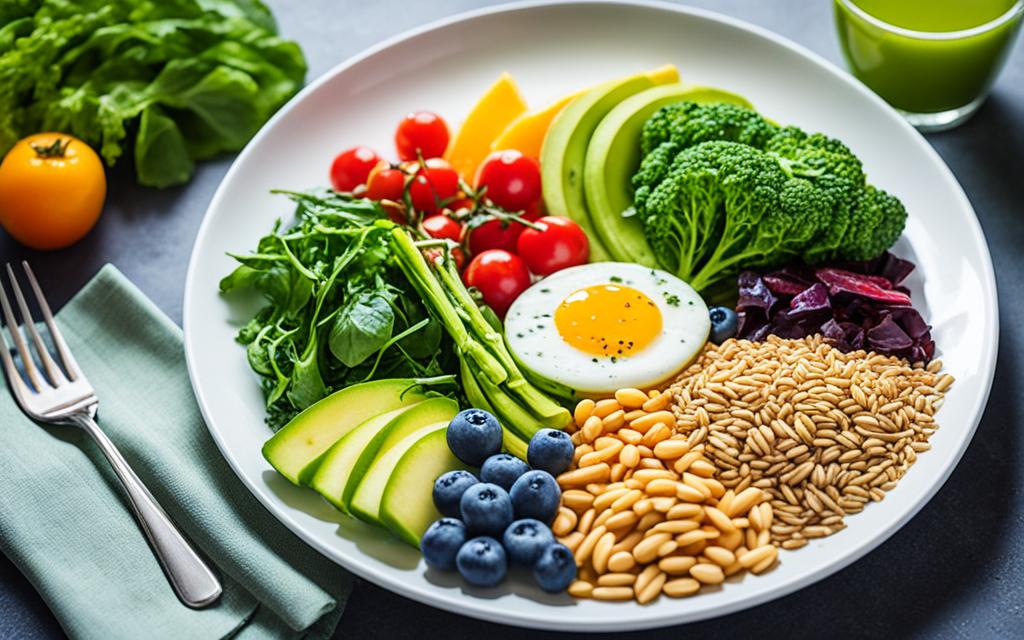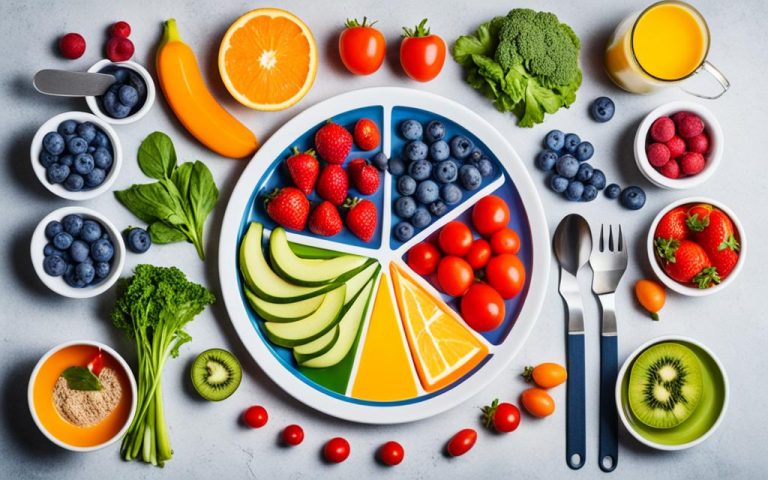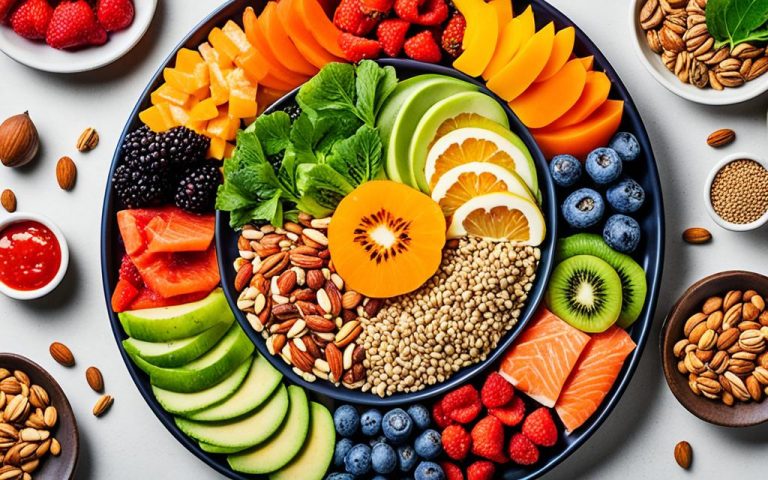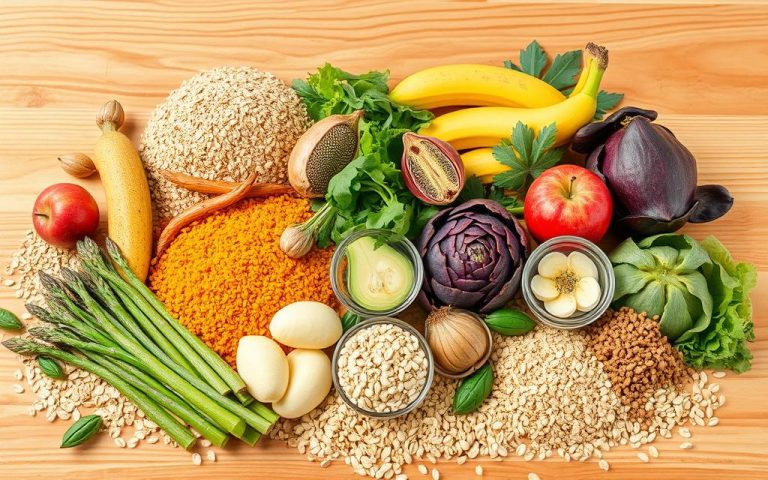Insulin Resistance Diet: Balance Blood Sugar Levels
Are you finding it hard to keep your blood sugar levels stable? You’re not the only one. Many people are looking for ways to make their insulin sensitivity better and get their health back on track. The insulin resistance diet can help. It gives a clear guide on what foods are best to keep your blood sugar in line and make your body respond better to insulin.
This diet is more than just cutting things out. It’s about changing how you live to connect more with what you eat. This helps you find the right balance for your blood sugar. You get to choose foods that help manage insulin resistance. Plus, this diet includes a lot of different tastes and healthy options that keep you happy.
Key Takeaways
- Embrace a diet that improves insulin sensitivity and supports healthy blood sugar balance.
- Discover foods that work in your favor, transforming the way your body responds to insulin.
- Recognize the importance of synergy between lifestyle and nutrition for managing insulin resistance.
- Learn that an insulin resistance diet is not only healthful but also diverse and delicious.
- Realize the power of personalized dietary choices in your journey to better health.
Understanding Insulin Resistance and Its Impact on Health
Insulin resistance is a serious health issue. It happens when body cells can’t use insulin properly. Insulin is key for managing blood sugar. This section helps you understand insulin resistance. You will learn about its symptoms and how it develops over time.
What Is Insulin Resistance?
Over time, the body’s use of insulin gets less effective. This leads to insulin resistance. The pancreas tries to make up for it by producing more insulin. This is to control blood sugar. But, this can lead to serious health issues if not checked. It’s important to understand insulin resistance to manage health better.
The Health Risks Associated With Insulin Resistance
Not treating insulin resistance can lead to big health problems. It raises the risk of getting type 2 diabetes, heart diseases, and metabolic syndrome. These conditions show the strong link between insulin resistance and overall health. Next, we give a detailed look at these health risks.
| Condition | Description | Connection to Insulin Resistance |
|---|---|---|
| Type 2 Diabetes | A long-term metabolic disorder characterized by high blood sugar, insulin resistance, and relative lack of insulin. | Often caused by ongoing insulin resistance, leading to issues with the pancreas. |
| Cardiovascular Disease | A class of diseases involving the heart or blood vessels. | Insulin resistance affects how the blood vessels work, raising the risk of heart disease. |
| Metabolic Syndrome | A group of conditions increasing the risk of heart disease, stroke, and diabetes. | Insulin resistance plays a major role in developing metabolic syndrome. |
Knowing these conditions and their ties to insulin resistance is key. It helps in taking steps to stay healthy and prevent worse health problems. For many around the world, managing insulin resistance is the first step towards long-lasting health.
Basics of Insulin Resistance Diet
Starting an insulin resistance diet can greatly help your health. It balances your blood sugar and improves insulin sensitivity. This diet is about eating healthy foods. These help manage blood sugar and stop spikes. This is key for those with insulin resistance.
Know what makes a good insulin resistance meal plan. It should have proteins, healthy fats, and carbs mainly from low glycemic foods. This helps control insulin reactions and keeps your energy levels stable all day.
- Consistent Meal Times: Eating regularly helps keep your blood sugar stable.
- Portion Control: Watch how much you eat to prevent high insulin spikes.
- Food Choices: Pick whole, unprocessed foods to avoid too much sugar and fat. These can make insulin resistance worse.
| Food Type | Example | Benefits |
|---|---|---|
| Whole Grains | Quinoa, Brown Rice | Rich in fiber, helps slow glucose absorption. |
| Lean Proteins | Chicken Breast, Lentils | Keeps muscle mass with low insulin spikes. |
| Healthy Fats | Avocado, Olive Oil | Makes you full longer and boosts insulin sensitivity. |
| Fruits & Vegetables | Blueberries, Spinach | Offers vital vitamins and antioxidants. |
Eating these foods makes your body’s insulin response better. Changing how you eat with an insulin resistance meal plan helps you now. It also protects against future blood sugar problems.
Switching to an insulin resistance diet means choosing wisely, not limiting yourself too much. Talk to a healthcare professional or a nutritionist. They can create a meal plan that fits your health needs. This ensures every meal is good for your body and insulin sensitivity.
Top Foods to Include in Your Insulin Resistance Diet
A diet rich in specific nutrients can greatly improve how you manage insulin resistance. Focus on foods that help keep your blood sugar stable. Foods high in healthy fats, complex carbohydrates, and essential nutrients are key.
Complex Carbohydrates for Sustained Energy
Complex carbohydrates keep your blood sugar steady and give you long-lasting energy. Foods like whole grains, legumes, and vegetables are top choices. They digest slowly, preventing sudden increases in blood sugar.
High-Fiber Foods to Promote Fullness
Fiber is crucial for good digestion and feeling satisfied. It’s important for controlling how much you eat and maintaining blood sugar balance. Adding high-fiber foods such as berries, nuts, and leafy greens to your diet helps control hunger. It also slows down sugar absorption.
Healthy Fats to Enhance Insulin Sensitivity
Healthy fats are important for boosting insulin sensitivity. Omega-3 rich foods like fish, avocados, and seeds enhance how cells respond to insulin. They also support heart health, important for people dealing with insulin resistance.
| Food Category | Examples | Benefits |
|---|---|---|
| Complex Carbohydrates | Whole grains, legumes, vegetables | Promotes stable blood sugar levels, provides sustained energy |
| High-Fiber Foods | Berries, nuts, leafy greens | Enhances fullness, aids in digestion |
| Healthy Fats | Fish, avocados, seeds | Improves insulin sensitivity, supports heart health |
Insulin Resistance Recipes for Balanced Blood Sugar
Managing insulin resistance begins by knowing which recipes are best. These recipes ensure your blood sugar stays stable all day. They’re perfect for breakfast, lunch, and dinner, fitting smoothly into your meal plan.
Breakfast Options to Kickstart Your Metabolism
Starting your day well is essential when managing insulin resistance. Having a breakfast rich in fiber and protein will get your metabolism going. This keeps your blood sugar in check.
Try oatmeal with nuts and berries, or a smoothie bowl. Add Greek yogurt and flaxseeds for extra nutrition. These options are great for breakfast.
Lunch Ideas to Maintain Blood Sugar Levels
For lunch, picking meals that boost your energy and balance blood sugar is key. Opt for salads with leafy greens, lean proteins, and colorful veggies. A homemade vinaigrette adds the perfect touch.
Grilled chicken or fish with quinoa and veggies is another good choice. It helps keep your blood sugar level through the afternoon.
Dinner Recipes to Avoid Blood Sugar Spikes
Dinner is a time to unwind without stressing over blood sugar. Choose dishes with lean proteins and vegetables with a low glycemic index. A turkey and vegetable stir-fry works well for this.
Use herbs and spices like turmeric and ginger for added flavor and health benefits. They also help with inflammation.
| Meal | Key Ingredients | Benefits |
|---|---|---|
| Breakfast | Oatmeal, nuts, berries, Greek yogurt, flaxseeds | High in fiber and protein, boosts metabolism |
| Lunch | Leafy greens, chicken, quinoa, colorful vegetables | Maintains steady blood sugar levels |
| Dinner | Turkey, low-GI vegetables, turmeric, ginger | Prevents blood sugar spikes, anti-inflammatory |
Foods to Avoid on an Insulin Resistance Diet
When you’re following an insulin resistance diet, it’s key to know what foods to avoid. Some foods can make insulin resistance worse. They should be limited or avoided to keep you healthy.
To manage your diet well, cut down on foods that spike your blood sugar. This includes foods that lead to insulin insensitivity. Here’s a list of foods to be cautious of:
- Sugary beverages: Sodas, fruit juices, and energy drinks
- Refined carbs: White bread, pastries, and other high-sugar baked goods
- Processed snacks: Chips, crackers, and microwave popcorn
- Fatty cuts of meat: Especially those high in saturated fats
- High-fat dairy products: Cream, full-fat yogurt, and ice cream
Avoiding these foods helps a lot in controlling insulin resistance. It also helps in keeping your blood sugar balance stable.
| Food Category | Examples | Reason to Avoid |
|---|---|---|
| Sugary beverages | Sodas, fruit juices | High sugar content spikes insulin |
| Refined carbs | White bread, pastries | Quick digestion increases blood sugar |
| Processed snacks | Chips, microwave popcorn | High in unhealthy fats and additives |
| Fatty meats | Bacon, salami | Saturated fats worsen insulin sensitivity |
| High-fat dairy | Cream, ice cream | High in fat and sugar, affecting insulin |
By avoiding these foods, you can handle your insulin resistance better. This helps maintain a good blood sugar balance. Remember, knowing what foods to not eat is as vital as knowing what to eat.
Meal Planning Strategies for Insulin Resistance
Managing insulin resistance means planning meals carefully. It’s about what and how you eat. You should balance your blood sugar by eating consistently throughout the day. Here are tips for meal planning to support your health.
How to Build a Balanced Plate
A balanced plate helps keep your blood sugar steady and boosts insulin sensitivity. Your plate should have:
- Complex carbohydrates like whole grains for a slow energy release.
- Lean proteins such as chicken, fish, or legumes for fullness and muscle upkeep.
- Lots of non-starchy vegetables for essential nutrients without glucose spikes.
- A little healthy fat from avocados, nuts, or olive oil for metabolism.
Control your portions; half vegetables, a quarter lean proteins, and a quarter complex carbs. Nutritionists recommend this for blood sugar balance.
Prepping Meals in Advance for Blood Sugar Control
Preparing meals ahead is key for blood sugar control. It saves time and ensures you have balanced meals ready. Here’s how to start:
- Choose a day to cook meals in batches. Make large amounts of stews, casseroles, or roasted veggies.
- Use your freezer. Freeze meals in the right sizes for easy reheating.
- Have snacks like nuts or whole grain crackers. They’re good for managing blood sugar.
With these strategies, you make better food choices. Your meal plan can stabilize blood sugar, improving your health.
Supplements That Support Insulin Resistance
Managing insulin resistance can get a big boost from the right supplements. It’s smart to add certain insulin resistance supplements, vitamins and minerals, and herbs for blood sugar balance to your daily routine. This helps your diet and exercise work even better.
Key Vitamins and Minerals
Some vitamins and minerals are key in keeping blood sugar stable and enhancing insulin sensitivity. Here are the nutrients you should know about:
- Magnesium – Important for carbohydrate metabolism and linked to better insulin sensitivity.
- Chromium – Boosts insulin action and is crucial for processing glucose.
- Vitamin D – Having enough Vitamin D reduces the risk of insulin resistance. It helps manage blood sugar.
- Zinc – Necessary for making insulin and maintaining blood sugar levels.
Herbs and Extracts for Blood Sugar Balance
Different herbs and extracts can help keep blood sugar levels stable and make insulin more effective. Take a look at these:
- Berberine – Found in several plants, it lowers blood sugar as well as some diabetes medicines do.
- Cinnamon – Used for ages, it can cut fasting blood sugar and make insulin work better.
- Fenugreek – Its high soluble fiber content slows down how fast carbs are absorbed, helping control sugar levels.
- Gymnema Sylvestre – Also known as ‘sugar destroyer’, it reduces sugar cravings and lowers sugar levels.
By adding these vitamins and minerals and herbs for blood sugar balance to your daily plan, you’re giving yourself a big helping hand in managing insulin resistance. This, along with lifestyle changes, can make a real difference.
Designing an Insulin Resistance Exercise Program
Starting an exercise plan for insulin resistance needs a mix of activities for the best health outcomes. Knowing how each exercise affects your body helps you make smart choices. This knowledge guides your exercise plan.
Cardiovascular Exercises to Enhance Insulin Sensitivity
Cardio exercises are key for better insulin sensitivity, a main part of any insulin resistance workout plan. Doing activities like walking fast, running, biking, or swimming helps a lot. They work by upping your heart rate and blood flow, which helps your muscles use sugar better and keeps insulin level steady.
Strength Training for Muscle Glucose Uptake
Adding strength training twice a week helps your muscles use sugar more effectively. Lifting weights, using bands, or doing squats and push-ups not only grows muscles. They also help lower sugar levels in your blood, which is vital for handling insulin resistance well.
| Exercise Type | Benefits | Frequency Recommended |
|---|---|---|
| Cardiovascular Exercises | Increases insulin sensitivity, improves heart health, enhances metabolism. | 3-5 times per week, 30-45 minutes each |
| Strength Training | Boosts muscle glucose uptake, increases muscle mass, assists in weight control. | 2-3 times per week, 20-30 minutes each |
Mixing cardio with strength training creates an effective workout for insulin resistance. This combo not only helps manage your condition. It also boosts overall health and fitness.
The Role of Sleep and Stress Management in Insulin Resistance
Managing insulin resistance isn’t just about what you eat and how much you move. Sleep quality and stress management are also key. They play a big role in controlling your blood sugar.
Getting good sleep can help your body use sugar better. Sticking to a regular bedtime keeps your hormones balanced. This balance is important for controlling insulin resistance. On the other side, managing stress well can keep stress hormones in check. These hormones can make your blood glucose spike.
| Aspect | Impact on Insulin Resistance |
|---|---|
| Sleep Duration | More sleep is linked to better insulin use and lower sugar levels. |
| Sleep Quality | Bad sleep can raise insulin resistance, while good sleep lowers it. |
| Stress Levels | Too much stress increases cortisol, making insulin resistance worse. |
| Stress Reduction Techniques | Using meditation, yoga, and breathing exercises helps lower stress and improve insulin sensitivity. |
Adding steps to improve sleep quality and cut down on stress is vital. For example, following a sleep schedule and using relaxation methods are good for your health. They also help diet and exercise efforts to lower insulin resistance.
A successful fight against insulin resistance includes everything that affects how insulin works in your body. Don’t focus on just one area.
Insulin Resistance Weight Loss Strategies
Dealing with insulin resistance can be a challenge. Yet, with the right strategy, losing weight and improving your health is possible. Managing your weight well is key for those with insulin resistance as it affects your metabolic health directly. We’ll show you some diet and lifestyle tips that can make a big difference.
Effective Diet Tips for Weight Loss
Your diet is crucial when it comes to losing weight with insulin resistance. It’s about more than just eating fewer calories. You need to eat foods that help with insulin sensitivity. A diet rich in nutrients, high in fiber, and low in processed sugars is essential. Here’s what you should do:
- Focus on high-fiber foods such as vegetables, legumes, whole grains, and fruits to help manage blood sugar levels.
- Incorporate lean proteins like fish, chicken, and plant-based options to support muscle repair and growth.
- Limit intake of high-sugar foods and beverages to prevent blood sugar spikes.
- Choose healthy fats from avocados, nuts, seeds, and olive oil to improve blood lipid levels.
Exercise and Lifestyle Changes for Sustainable Weight Management
Being active is vital for managing insulin resistance and losing weight. Exercise lowers blood sugar and increases insulin sensitivity. Pairing regular physical activity with major lifestyle changes is key for lasting weight management:
- Engage in at least 150 minutes of moderate exercise per week, like brisk walking or cycling.
- Do strength training twice a week to build muscle and improve glucose uptake.
- Get 7-9 hours of sleep each night to help control hunger and appetite hormones.
- Use mindfulness practices like yoga, meditation, or deep breathing to manage stress.
By following these diet and lifestyle tips, you can greatly improve your insulin sensitivity. This fosters effective, long-lasting weight management. Remember, achieving better health is a slow journey that requires steadfastness and dedication.
| Daily Habits | Benefits |
|---|---|
| High-fiber, balanced meals | Stabilizes blood sugar levels |
| Regular physical activity | Increases insulin sensitivity |
| Stress management | Reduces hormonal imbalances that affect weight gain |
| Sufficient sleep | Regulates hormones that control appetite |
Tracking Your Progress on an Insulin Resistance Diet
Starting an insulin resistance diet means you’re taking charge of your health. The real secret to success is tracking progress. By monitoring blood sugar regularly and adjusting your eating habits, you can make the most out of your diet. This can lead to better health results.
Monitoring Blood Sugar Levels
Checking your blood sugar often is key when you’re on this diet. It shows you how food impacts your sugar levels. This helps you make smart choices about what to eat. Using a glucose monitor can really help in understanding these changes.
Adjusting Your Diet for Optimum Results
After seeing your blood sugar data, you might need to change your diet. Knowing which foods raise your sugar or improve insulin sensitivity helps. Then you can adjust your diet to get healthier.
| Time of Day | Average Blood Sugar Before Diet | Average Blood Sugar After Diet Adjustments |
|---|---|---|
| Morning | 150 mg/dL | 130 mg/dL |
| Afternoon | 145 mg/dL | 120 mg/dL |
| Evening | 160 mg/dL | 140 mg/dL |
Monitoring your numbers closely and adjusting what you eat makes sure the diet works for you. It also helps in managing your health effectively. Remember, every little change adds up to big benefits for your health.
Success Stories: Transformations with an Insulin Resistance Diet
Many have changed their lives by following an insulin resistance diet. They have not only improved their blood sugar balance but also their overall health. Let’s look at some success stories that showcase the benefits of dietary changes for insulin resistance.
- One person saw their energy levels and metabolic health soar. By sticking to an insulin resistance diet, they kept their blood sugar stable and lowered their HbA1c.
- Another story is about someone who battled with unstable blood sugar and constant tiredness. After a few months on a specific diet, they felt more energetic. Their blood sugar levels stabilized, and they managed their hunger better.
These experiences show the power of an insulin resistance diet in keeping blood sugar healthy. This diet, rich in nutrients and low in high-glycemic foods, supports overall health and energy.
Eating this way doesn’t just control symptoms; it can transform how you feel every day. It encourages a passion for a healthier life.
Each story highlights how personal diet changes can greatly improve health. They show that dedicating yourself to an insulin resistance diet can mean taking control of your health.

Conclusion
Taking on an insulin resistance diet is about more than changing what you eat. It’s a step to better your health and get your blood sugar right. You’ve learned how closely your diet and lifestyle choices affect your insulin sensitivity. By choosing complex carbs, fiber-rich foods, and good fats, you’ll find a balance. And it’s just as important to avoid foods that mess with insulin function.
Meal planning helps a lot, and when you add regular workouts, the benefits grow. Lifting weights and doing cardio are great for making your body more sensitive to insulin. Don’t forget that getting enough sleep and handling stress also play a big part. Together, they form a complete strategy for dealing with insulin resistance.
See this not just as following rules, but as moving toward being your healthiest self. You have the info and tips you need to lead well. Each choice you make about food, exercise, and how you live boosts your insulin sensitivity. You’re on your way to a healthier, more balanced life.
FAQ
What is an insulin resistance diet?
It’s a meal plan focused on improving blood sugar balance and insulin sensitivity. It includes foods high in fiber, healthy fats, and complex carbs. It avoids processed foods and sugars to help manage insulin resistance.
How does insulin resistance impact health?
Insulin resistance decreases the body’s ability to use insulin, raising blood sugar levels. Over time, it can lead to serious health problems like type 2 diabetes, heart disease, and metabolic syndrome.
What foods should I include in my insulin resistance diet?
Include complex carbs (like oats and quinoa), high-fiber foods (like vegetables and legumes), and healthy fats (like avocados and nuts). These foods help you feel full, provide energy, and boost insulin sensitivity.
Are there specific recipes that can help manage blood sugar levels?
Yes, there are recipes that help keep blood sugar in check. They offer nutrient-dense breakfasts, balanced lunches, and dinners to prevent sugar spikes.
Which foods should I avoid on an insulin resistance diet?
Avoid sugary snacks and drinks, highly processed foods, refined carbs, and trans fats. These can make insulin resistance worse and unsettle blood sugar levels.
Can supplements aid in managing insulin resistance?
Some supplements, like magnesium, chromium, cinnamon, and fenugreek, may help with blood sugar balance. But, always talk to a healthcare provider before starting any supplements.
What type of exercise is beneficial for insulin resistance?
Cardio exercises and strength training are both beneficial. Cardio improves insulin sensitivity while strength training helps muscles use glucose more effectively.
How can sleep and stress management affect insulin resistance?
Getting enough sleep and managing stress are key for good health and can greatly affect insulin sensitivity. Poor sleep and high stress can worsen insulin resistance.
What strategies can support weight loss with insulin resistance?
For weight loss, eat whole, nutrient-rich foods, stay active, get good sleep, and manage stress. These steps can help with insulin resistance.
How should I track my progress on an insulin resistance diet?
Regularly check your blood sugar levels and adjust your diet to keep them balanced. Also track your weight, energy, and overall well-being to gauge your progress.
Are there real-life success stories of people managing insulin resistance through diet?
Yes, many people have beaten insulin resistance with a specialized diet. Their success stories can encourage others to make healthy changes.







